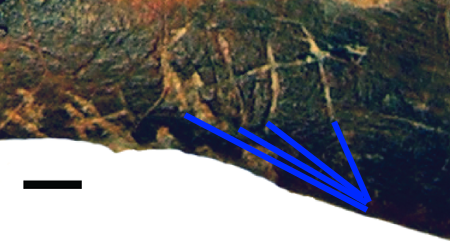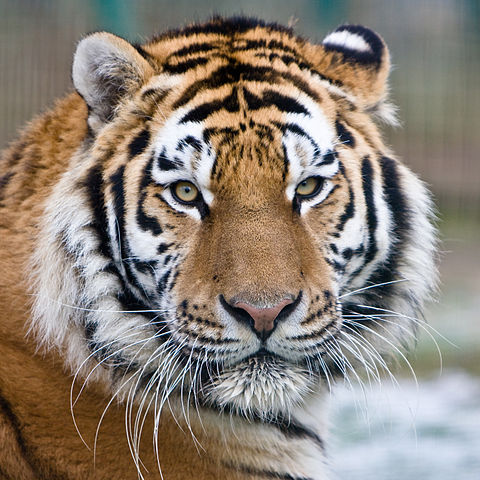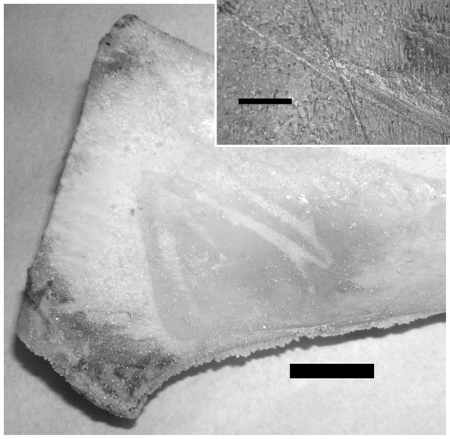Not Just Jaws…Claws Mark Bone Too!
After a long journey through the millennia, fossils inevitably arrive in the present as damaged goods. Bacteria, scavengers, erosion, wind, rain, and even sunlight conspire to destroy the remains of previously living organisms. Although this loss of information is a bad thing for understanding many aspects of a long-gone organism, some post mortem adventures actually add data to the fossil record. A whole subfield of paleontology–taphonomy–focuses on this very topic.
Some of my favorite taphonomic artifacts are feeding traces–particularly the bite marks left behind by carnivorous animals. These traces tell us who fed on whom, and how they did so. Spend some time with fossil bones, and you are quite likely to run across these bite marks. For instance, a recent study in PLOS ONE documented croc bite marks on juvenile dinosaur bones, with one croc even leaving a tooth embedded in the bone. These kinds of fossils help paleontologists reconstruct the long-vanished food webs of prehistoric ecosystems.

Because bite marks are so common, it’s easy to get in a rut and assume that all traces on bone result from bite marks. One great counterexample is trample marks–if a bone is pressed into the ground, sand and gravel can score the bone surface, mimicking bite marks or even human tool marks. Several colleagues and I also hypothesized that Triceratops may have injured each other with their horns, and Joe Peterson and colleagues inferred head-butting damage in the skulls of pachycephalosaur dinosaurs. A new study in PLOS ONE comes up with an even more interesting possibility–claw marks.
Claws–whether they are in birds, tyrannosaurs, or tigers–are covered by a keratinous sheath, pretty much equivalent to our fingernails. We all know that this keratin is fairly soft, particularly relative to bone. (If you’re a meat-eater, try to scratch the bony surface of that t-bone or pork chop next time you throw one on the grill) So, you really wouldn’t expect to see claw marks in the fossil record. To investigate this assumption, Bruce Rothschild and colleagues set up a nifty experiment.

Photo by Nick Jewell, CC-BY.
Rather than try to simulate claw damage in the laboratory, Rothschild and colleagues went straight to the source–a real, live tiger. Conveniently, zoos strive to give their animals a variety of boredom-alleviating enrichment activities. These can be a simple puzzle with a piece of food inside, or a ball to bat around, or in this case, a scientific experiment. The researchers devised a simple but effective contraption–a beef bone bolted into a piece of wood, inset so that sharp tiger teeth couldn’t get to it. If anything was going to mark the bone, it had to be the claws. Add the contraption to the tiger enclosure at a local zoo, and see what happens.
Contrary to expectations, the bone was quite prominently marked by tiger claws. These marks showed up at all levels of magnification (see image below).

So, this means that paleontologists should probably be on the look-out for claw marks in the fossil record. As noted by Rothschild and colleagues, potential claw damage was previously spotted in monkey carcasses that had been feasted upon by eagles. The next step, of course, will be to see if the signatures of teeth and claws can be adequately distinguished by their traces. It would also be great to repeat the experiment with other kinds of bones and other animals.
All in all, this paper presents some pretty cool results. My only “major” quibble concerns part of the abstract, which seemingly refers to the marks as “pathology” (this came up in a recent discussion about the paper with some friends on Facebook). Pathology generally refers to disease processes in living organisms, and “taphonomy” is far more appropriate terminology here. I think the authors may be angling towards distinguishing claw- and tooth-induced injuries that occurred within the lifetime of the animal, but that topic isn’t covered by the paper. That too, presents an interesting question, and is definitely one for future research.
You can read the new paper here. For another look at the research, check out Brian Switek’s blog post.
Citations
Boyd CA, Drumheller SK, Gates TA (2013) Crocodyliform Feeding Traces on Juvenile Ornithischian Dinosaurs from the Upper Cretaceous (Campanian) Kaiparowits Formation, Utah. PLoS ONE 8(2): e57605. doi:10.1371/journal.pone.0057605
Rothschild BM, Bryant B, Hubbard C, Tuxhorn K, Kilgore GP, et al. (2013) The Power of the Claw. PLoS ONE 8(9): e73811. doi:10.1371/journal.pone.0073811
